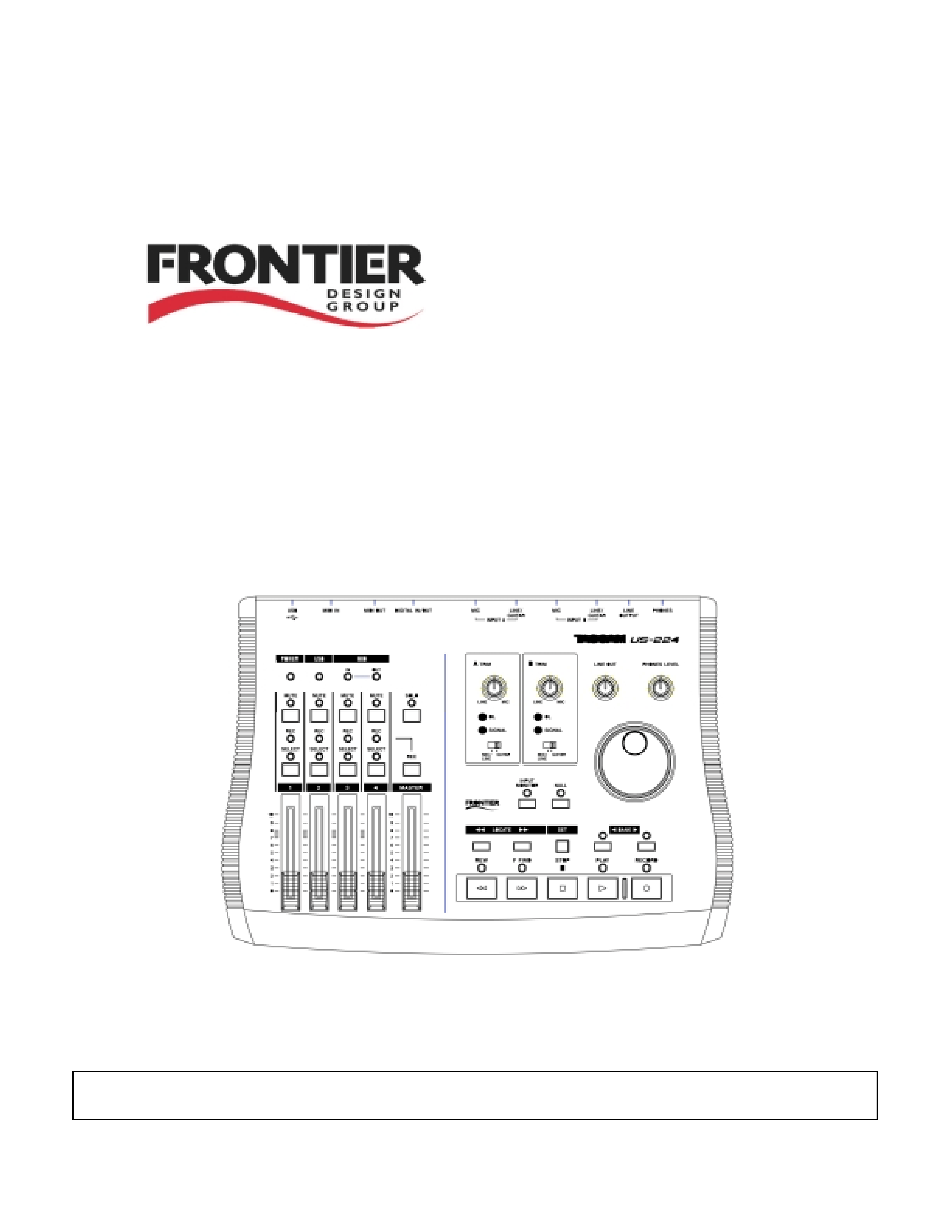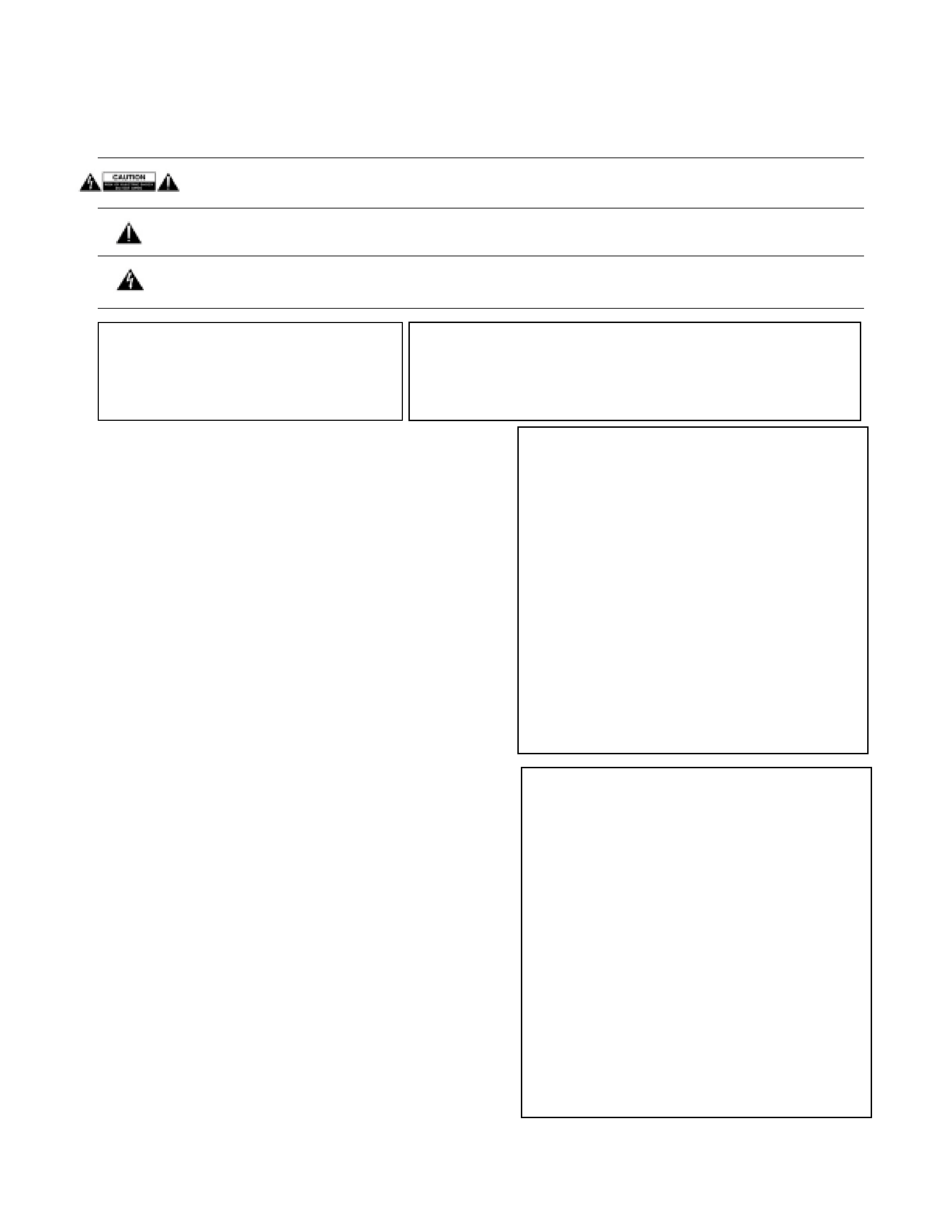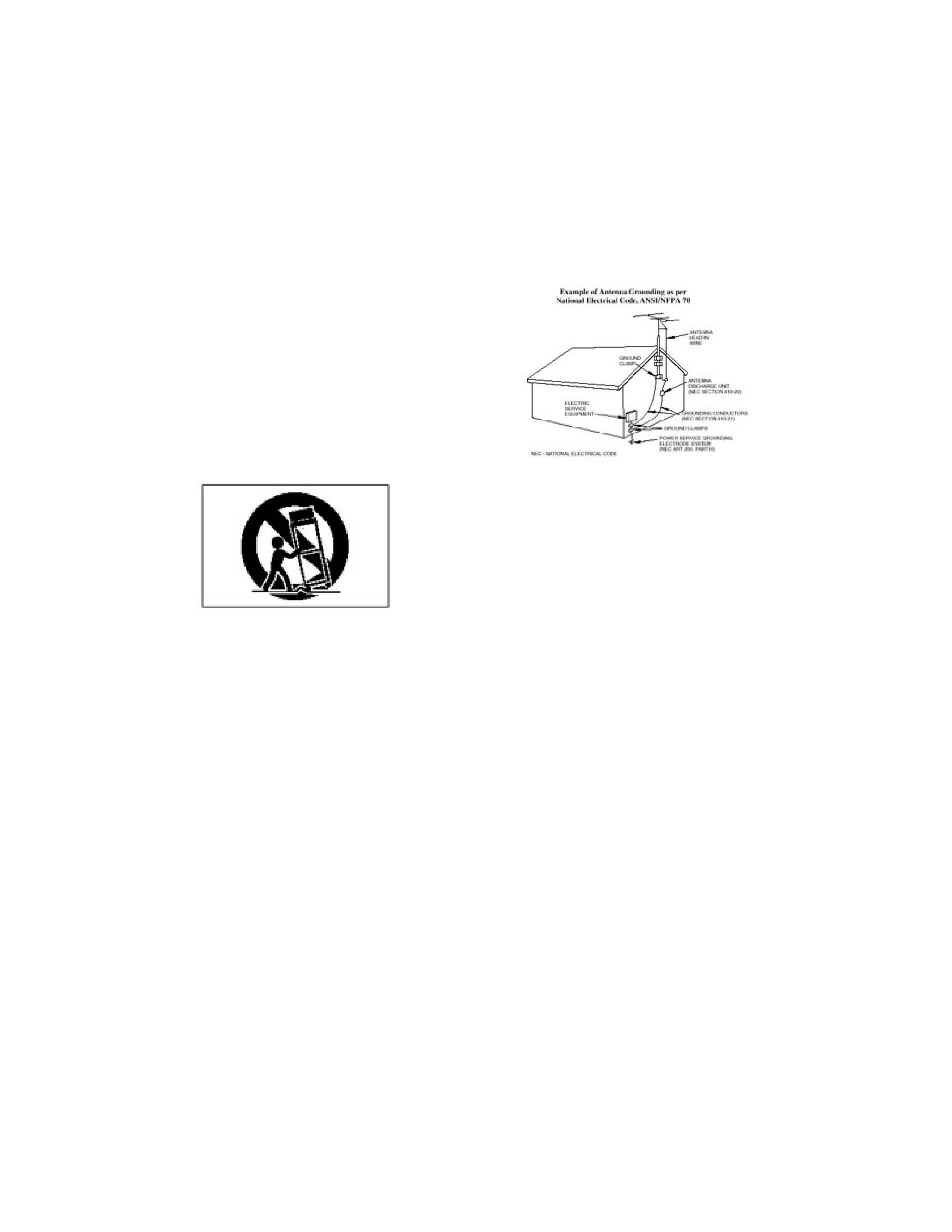
1
TASCAM
TEAC Professional Division
US-224
Universal Serial Bus
Digital Audio Workstation Controller
OWNER'S MANUAL
D000640100A

2
Important Safety Precautions
CAUTION: TO REDUCE THE RISK OF ELECTRIC SHOCK, DO NOT REMOVE COVER (OR BACK). NO
USER-SERVICEABLE PARTS INSIDE. REFER SERVICING TO QUALIFIED SERVICE PERSONNEL.
The exclamation point within an equilateral triangle is intended to alert the user to the presence of important
operating and maintenance (servicing) instructions in the literature accompanying the appliance.
The lightning flash with arrowhead symbol, within equilateral triangle, is intended to alert the user to the
presence of uninsulated "dangerous voltage" within the product's enclosure that may be of sufficient magnitude
to constitute a risk of electric shock to persons
For U.S.A
This appliance has a serial number located on the
rear panel. Please record the model number and
serial number and retain them for your records.
Model number ______________________
Serial number
WARNING:
TO
PREVENT
FIRE
OR
SHOCK HAZARD, DO NOT EXPOSE THIS
APPLIANCE TO RAIN OR MOISTURE.
IMPORTANT (for U.K. Customers)
DO NOT cut off the mains plug from this equipment.
If the plug fitted is not suitable for the power points in your home or
the cable is too short to reach a power point, then obtain an
appropriate safety approved extension lead or consult your dealer.
If nonetheless the mains plug is cut off, remove the fuse and dispose
of the plug immediately, to avoid a possible shock hazard by
inadvertent connection to the mains supply.
If this product is not provided with a mains plug, or one has to be
fitted, then follow the instructions given below:
IMPORTANT: The wires in this mains lead are coloured in
accordance with the following code:
GREEN-AND-YELLOW
: EARTH
BLUE
: NEUTRAL
BROWN
: LIVE
WARNING: This apparatus must be earthed.
As the colours of the wires in the mains lead of this apparatus may
not correspond with the coloured markings identifying the terminals in
your plug proceed as follows:
The
wire
which
is
coloured
GREEN-and-YELLOW
must
be
connected to the terminal in the plug which is marked by the letter E
or by the safety earth symbol ç or coloured GREEN or GREEN-and-
YELLOW.
The wire which is coloured BLUE must be connected to the terminal
which is marked with the letter N or coloured BLACK.
The wire which is coloured BROWN must be connected to the
terminal which is marked with the letter L or coloured RED.
When replacing the fuse only a correctly rated approved type
should be used and be sure to refit the fuse cover.
IF IN DOUBT -- CONSULT A COMPETENT ELECTRICIAN.
For U.S.A
TO THE USER
This equipment has been tested and found to comply with
the limits for a Class A digital device, pursuant to Part 15 of
the FCC Rules. These limits are designed to provide
reasonable protection against harmful interference when
the equipment is operated in a commercial environment.
This equipment generates, uses, and can radiate radio
frequency energy and, if not installed and used in
accordance with the instruction manual, may cause
harmful interference to radio communications. Operation of
this equipment in a residential area is likely to cause
harmful interference in which case the user will be required
to correct the interference at his own expense.
CAUTION
Changes or modifications to this equipment not expressly
approved by TEAC CORPORATION for compliance could
void the user's authority to operate this equipment.
For the consumers in Europe
WARNING
This is a Class A product. In a domestic environment, this
product may cause radio interference in which case the
user may be required to take adequate measures.
Pour les utilisateurs en Europe
AVERTISSEMENT
Il s'agit d'un produit de Classe A. Dans un environnement
domes-tique, cet appareil peut provoquer des interférences
radio, dans ce cas l'utilisateur peut être amené à prendre
des mesures appro-priées.
Für Kunden in Europa
Warnung
Dies is eine Einrichtung, welche die Funk-Entstörung nach
Klasse A besitzt. Diese Einrichtung kann im Wohnbereich
Funkstörungen versursachen ; in diesem Fall kann vom
Betrieber verlang werden, angemessene
Maßnahmen
durchzuführen und dafür aufzukommen.

3
Read all of these Instructions.
Save these Instructions for later use.
Follow all Warnings and Instructions marked on the audio equipment.
1) Read instructions -- All the safety and operating instructions
should be read before the product is operated.
2) Retain instructions -- The safety and operating
instructions
should be retained for future reference.
3) Heed Warnings -- All warnings on the product and
in the
operating instructions should be adhered to.
4) Follow instructions -- All operating and use instructions should
be followed.
5) Cleaning -- Unplug this product from the wall outlet
before
cleaning. Do not use liquid cleaners or aerosol
cleaners. Use a
damp cloth for cleaning.
6) Attachments -- Do not use attachments not recommended by
the product manufacturer as they may cause hazards.
7) Water and Moisture -- Do not use this product near water _ for
example, near a bath tub, wash bowl, kitchen sink, or laundry tub; in
a wet basement; or near a swimming pool; and the like.
8) Accessories -- Do not place this product on an unstable cart,
stand, tripod, bracket, or table. The
product may fall, causing
serious injury to a child or adult, and serious damage to the product.
Use only with a cart, stand, tripod, bracket, or table recommended
by the manufacturer, or sold with the product. Any mounting of the
product should follow the
manufacturer's instructions, and should
use a mounting accessory recommended by the manufacturer.
9) A product and cart combination should be moved
with care.
Quick stops, excessive force, and uneven surfaces may cause the
product and cart combination overturn.
10) Ventilation -- Slots and openings in the cabinet are provided for
ventilation and to ensure reliable
operation of the product and to
protect it from overheating, and these openings must not be blocked
or covered. The openings should never be blocked by placing the
product on a bed, sofa, rug, or other similar surface. This product
should not be placed in a built-in installation such as a bookcase or
rack unless proper
ventilation is provided or the manufacturer's
instructions have been adhered to.
11) Power Sources -- This product should be operated only from
the type of power source indicated on the marking label. If you are
not sure of the type of power supply to your home, consult your
product dealer or local power company. For products intended to
operate from battery power, or other sources, refer to the operating
instructions.
12) Grounding or Polarization -- This product may be equipped
with a polarized alternating-current line plug
(a plug having one
blade wider than the other). This plug will fit into the power outlet
only one way. This is a safety feature. If you are unable to insert the
plug fully into the outlet, try reversing the plug. If the plug should
still fail to fit, contact your electrician to replace your obsolete outlet.
Do not defeat the safety purpose of the polarized plug.
13) Power-Cord Protection -- Power-supply cords
should be
routed so that they are not likely to be walked
on or pinched by
items placed upon or against them,
paying particular attention to
cords at plugs, convenience receptacles, and the point where they
exit from the product.
14) Outdoor Antenna Grounding -- If an outside antenna or cable
system is connected to the product, be sure the antenna or cable
system is grounded so as to provide some protection against voltage
surges and
built-up static charges. Article 810 of the National
Electrical Code, ANSI/NFPA 70, provides information with regard to
proper grounding of the mast and supporting structure, grounding of
the lead-in wire to an
antenna discharge unit, size of grounding
conductors,
location of antenna-discharge unit, connection to
grounding
electrodes,
and
requirements
for
the
grounding
electrode.
"Note to CATV system installer:
This reminder is provided to call the CATV system installer's
attention to
Section 820-40 of the NEC which provides guidelines for proper
grounding
and, in particular, specifies that the cable ground shall be connected
to the
grounding system of the building, as close to the point of cable entry
as practical.
15) Lightning For added protection for this product during a
lightning storm, or when it is left unattended and unused for long
periods of time, unplug it from the wall outlet and disconnect the
antenna or cable system. This will prevent damage to the product
due to lightning and power line surges.
16) Power Lines An outside antenna system should not be
located in the vicinity of overhead power lines or other electric light
or power circuits, or where it can fall into such power lines or circuits.
When installing an outside antenna system, extreme care should be
taken to keep from touching such power lines or circuits as contact
with them might be fatal.
17) Overloading Do not overload wall outlets, extension cords, or
integral convenience receptacles as this can result in fire or electric
shock. Never spill liquid of any kind on the product..
18) Object and Liquid Entry Never push objects of any kind into
this product through openings as they may touch dangerous voltage
points or short out parts that could result in a fire or electric shock.
Never spill liquid of any kind on the product.
19) Servicing Do not attempt to service this product yourself as
opening or removing covers may expose you to dangerous voltage
or other hazards. Refer all servicing to qualified service personnel.
20) Damage Requiring Service Unplug this product from the wall
outlet and refer servicing to qualified service personnel under the
following conditions:
a) when the power supply cord or plug is damaged
b) if liquid has been spilled or objects have fallen into the product
c) if the product has been exposed to rain or water
d) if the product does not operate normally by following the
operating instructions. Adjust only those controls that are covered
by the operating instructions as an improper adjustment
of other
controls may result in damage and will often require extensive work
by a qualified technician to restore the product to its normal
operation
e) if the product has been dropped or damaged in any way
f) when the product exhibits a distinct change in performance this
indicates a need for service.
21) Replacement Parts When replacement parts are required, be
sure the service technician has used replacement parts specified by
the manufacturer or have the same characteristics as the original
part. Unauthorized substitutions may result in fire, electric shock or
other hazards.
22) Safety Check Upon completion of any service or repairs to this
product, ask the service technician to perform safety checks to
determine that the product is in proper operating condition.
23) Wall or Ceiling Mounting the product should be mounted to a
wall or ceiling only as recommended by the manufacturer.
24) Heat The product should be situated away from heat sources
such as radiators, heat registers, stoves or other product (including
amplifiers ) that produce heat.
SAFETY INSTRUCTIONS

4
This product is designed to help you record and
reproduce sound works to which you own the
copyright, or where you have obtained permission
from the copyright holder or the rightful licensor.
Unless you own the copyright, or have obtained
the appropriate permission from the copyright
holder or rightful licensor, your unauthorized
recording, reproduction or distribution thereof may
result in severe criminal penalties under copyright
laws and international copyright treaties. If you
are uncertain about your rights contact your legal
advisor. Under no circumstances will TEAC
Corporation be responsible for the consequences
of any illegal copying performed using the US-
224.
TEAC Corporation can take no responsibility for
any loss of data stored on hard disk, or any other
media, or on MIDI equipment such as
sequencers, etc. In case of such loss, TEAC
Corporation will in no way be liable for any
damages, consequential or otherwise, caused by
such loss of data.
Microsoft, Windows, Windows NT and
Windows XP are all registered trademarks
or trademarks of Microsoft in the US
and/or other countries.
The full name of the product referred to as
"Windows 98" is "Microsoft® Windows®
98 operating system."
Pentium is a registered trademark of Intel
Corporation
MIDI is a registered trademark of the
Association of Manufacturers of Electronic
Instruments (AMEI)
All other brands or product names are
trademarks of their respective companies
or organizations.
Declaration of Conformity
Model Number :
US-224
Trade Name
:
TASCAM
Responsible Party :
TEAC America, Inc
7733 Telegraph Road
Montebello, CA 90640
Telephone Number:
1-323-726-0303
This device complies with Part 15 of the FCC rules.
Operation is subject to the following two conditions:
1.
This
device
may
not
cause
harmful
interference, and
2.
This device must accept any interference
received, including interference that may cause
undesired operation.

5
Table of Contents
Table of Contents........................................ 5
Introduction ................................................. 6
1.1 Overview............................................ 6
1.2 Features ............................................ 6
1.3 What's in the package ....................... 6
1.4 Nomenclature used in this manual.... 6
2. Controls and Indicators ........................... 7
2.1 Front Panel ........................................ 7
2.2 Rear Panel ........................................ 8
2.3 Front Panel Descriptions ................... 9
2.4 Rear Panel Descriptions.................. 10
3. Installation ............................................. 11
3.1 System Requirements ..................... 11
3.2 Installation ....................................... 12
3.2.1 Windows ................................... 12
3.2.2 Macintosh ................................. 14
3.3 Setting Up OMS (MacOS Only) ...... 14
3.4 Tuning Your PC ............................... 14
3.5 Notes on USB interfacing ................ 16
4. Hooking up Audio and MIDI to the US-224
.................................................................. 17
4.1 Hooking up audio ............................ 17
4.2 Hooking up MIDI.............................. 18
4.3 Using the Input Monitoring .............. 18
4.4 Monitor vs. Master Level ................. 19
5. The US-224 Control Panel.................... 20
5.1 Main Page ...................................... 20
5.2 Buffer Size Adjustment................... 21
5.3 The Chromatic Tuner ..................... 21
6. Interfacing with your Audio Software .... 23
6.1 Selecting the US-224 as your Audio
Device.................................................... 23
6.1.1 Audio Control Panel.................. 23
6.1.2. ASIO Control Panel ................. 23
6.1.3 VST Remote ............................. 23
6.2 Setting the Sample Rate and Bit
Depth ..................................................... 24
6.3 Input Enabling ................................. 24
6.4 Transport Controls and Locate Points
............................................................... 25
6.5 Mute/Solo ........................................ 26
6.6 Data Wheel...................................... 26
6.7 BANK Controls and FADER NULL.. 26
6.8 ASIO2 Direct Monitoring................. 26
7. A Sample Recording Session in Cubasis
.................................................................. 28
7.1 Setting Up........................................ 28
7.2 Recording Your Tracks.................... 29
7.3 Overdubbing .................................... 29
7.4 Mixdown .......................................... 30
8. Other Applications and US-428 Emulation
Mode ......................................................... 31
8.1 Setting up Sound Manager Support
(for use with ProTools Free and Other
MacOS Applications) ............................. 32
9. Technical Support ................................. 34
9.1 Troubleshooting ............................... 34
9.2 Tech Support Contacts.................... 34
9.3 Troubleshooting FAQs..................... 35
Appendix A - MIDI Implementation Chart . 36
Appendix B Control Protocol .................. 37
Appendix C - US-224 Technical
Specifications ............................................ 42
